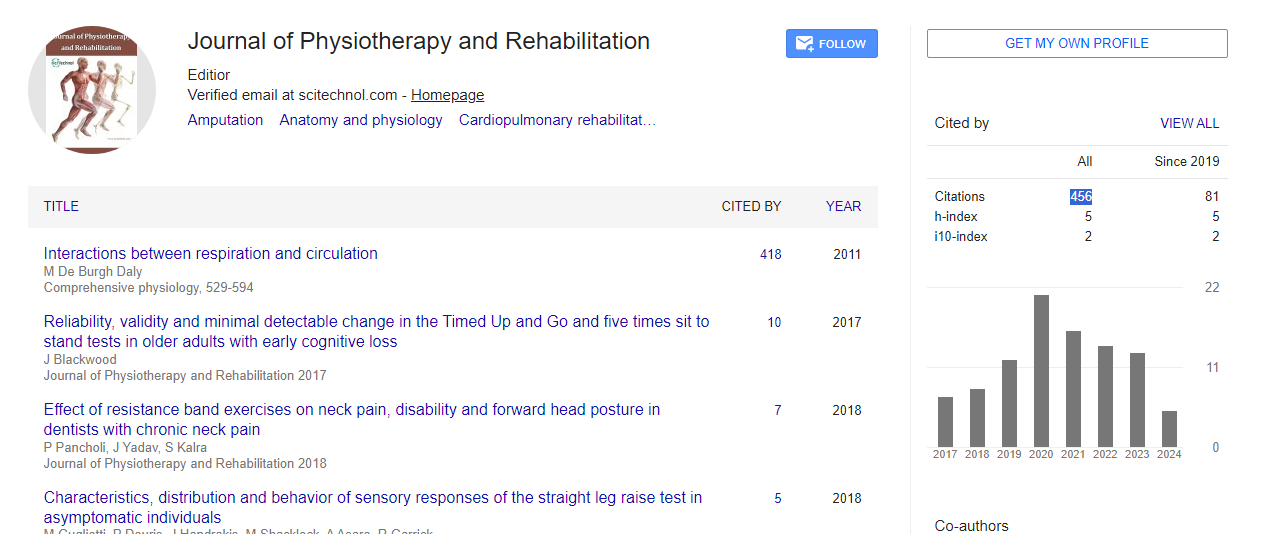Commentary, J Physiother Rehabil Vol: 5 Issue: 11
A Brief Note on neck pain and Neurologic symptoms
Susan Torreano*
Department of Physical Therapy, University of Miami, Coral Gables, Florida
*Corresponding author: Susan Torreano, Department of Agricultural Science, University of Toronto, Mexico City, Mexico, E-mail: torreano_s@gmail.com
Received date: 02 November, 2021; Accepted date: 23 November, 2021; Published date: 30 November, 2021
Abstract
A 20-year old healthy male varsity basketball player with a healthy diet, no Celiac Disease, no history of direct trauma or other concerning risk factors, presented with right forearm pain at the end of the summer at the peak of preseason training. The pain had an insidious onset and progression over a period of two weeks (pain 5/10 with palpation and tuning fork vibration which increased to 7/10 with basketball). Most commonly runners are reported to have stress fractures in the lower extremities due to the stress that occurs from repeatedly striking the ground. Many factors have been reported to contribute to stress fractures some of which include: hard training surface, changes in intensity speed or distance, lack of recovery time and individual biomechanical differences.
Description
A 20-year old healthy male varsity basketball player with a healthy diet, no Celiac Disease, no history of direct trauma or other concerning risk factors, presented with right forearm pain at the end of the summer at the peak of preseason training. The pain had an insidious onset and progression over a period of two weeks (pain 5/10 with palpation and tuning fork vibration which increased to 7/10 with basketball). Most commonly runners are reported to have stress fractures in the lower extremities due to the stress that occurs from repeatedly striking the ground. Many factors have been reported to contribute to stress fractures some of which include: hard training surface, changes in intensity speed or distance, lack of recovery time and individual biomechanical differences. The player had significantly increased the frequency, duration and volume of shooting and found this to aggravate the forearm pain. He reported that the average number of shots taken in a standard practice would equate to approximately 1000 and he had estimated that he had increased this number significantly and had been performing over 1500 shots daily during the preseason training. He started to develop point tenderness along the ulna that worsened with therapy (deep tissue work and ultrasound) and with daily use of the arm at school or while studying (i.e. writing or typing). He started to experience night pain, pain at rest, pain opening doors, and pain tying his shoes, so he consulted with the team physician for an assessment
Stress Fractures
There was no report of neck pain or neurologic symptoms. Initial radiograph showed a slight periosteal reaction of the mid shaft of the ulna and a faint linear density in the mid right radius suspicious for stress fracture. Stress fractures are common overuse injuries resulting from repetitive submaximal loads being applied to bone resulting in accumulated trauma that is greater than the ability of the skeletal system to repair. Bone is continually attempting to remodel and repair itself during sport when remarkable stress is applied to the bone. The individual stress of each event is not enough to fracture the bone; however, overtime the accumulation of stress leads to a stress fracture as the body is unable to repair the force that has been applied to the bone repeatedly. The stress that occurs in sports is the load that is being applied during the activity which varies depending on what sport is initial assessment he was tender on palpation involved. There was no visible bruising or swelling and there was no discomfort with active or passive range of motion of the wrist or elbow. There was less pain at rest (3/10) in a neutral position. There was no tenderness along the extensor or flexor muscle bellies and there was no pain elicited with resisted wrist flexion or extension as long as minimal torque was applied to the forearm. The athlete was treated with relative rest (i.e., pain free gentle activities) of the forearm and activity modification as well as supportive therapy by the team athletic therapist. This consisted of ice and heat for comfort, range of motion exercises and light tissue work. He was able to tolerate shooting during light scrimmage situations (one repetition) but he had not resumed shooting practice and repetitive drills. A protective shield was molded by the athletic therapist to protect the bone in case of inadvertent contact in a practice/game situation. He was advised to avoid shooting practice and repetitive drills but was permitted to participate in a modified practice (i.e., running, foot work drills, lower body weights, core work, shooting with the opposite arm etc.). When seen in follow-up 3 weeks later his pain had improved significantly and he was no longer experiencing pain at rest. He continued to report mild tenderness on palpation of the ulna (3/10) so modified practice was continued and repeat radiographs were ordered and reported as normal. A gradual progressive return to shooting protocol was developed, starting with an additional 25 shots per practice for the first week. This gradual progressive return to play strategy was well tolerated and the player was able to progress back to full practice and games with no ongoing forearm pain while shooting a basketball within 4 weeks of the onset of pain.
 Spanish
Spanish  Chinese
Chinese  Russian
Russian  German
German  French
French  Japanese
Japanese  Portuguese
Portuguese  Hindi
Hindi 